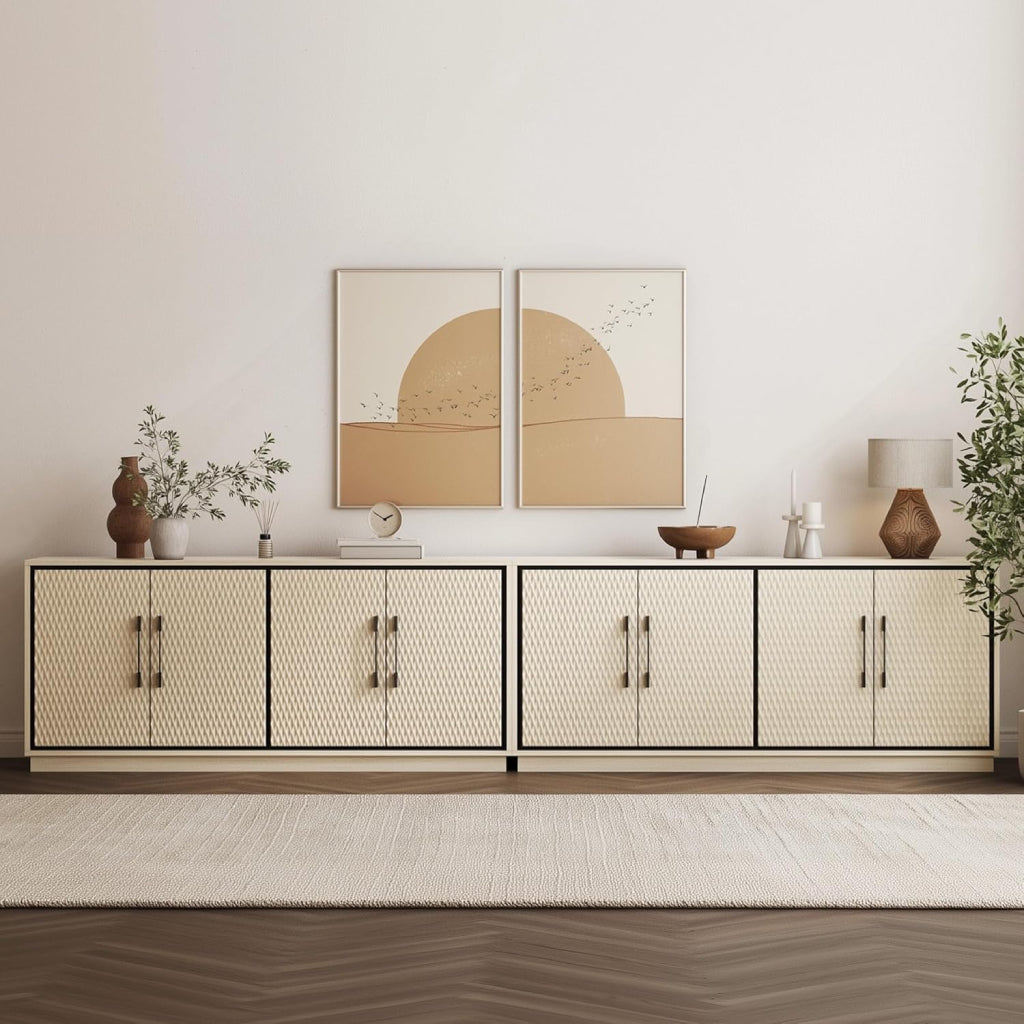When shopping for storage furniture for your dining room or living room, you'll likely encounter three similar-looking pieces: buffets, sideboards, and credenzas. It's easy to mix them up—they look alike and serve similar purposes. However, each has distinct characteristics that set it apart from the others.
This guide is here to cut through the confusion. We'll break down the key differences between these three classic furniture types in simple terms, show you clear examples, and help you choose the perfect piece for your home and lifestyle.
Sideboard vs. Buffet vs. Credenza: Direct Comparison
For those in a hurry, here’s a simple table that breaks down the main differences at a glance.
| Feature | Sideboard | Buffet | Credenza |
| Primary Use | Dining & Living Room Storage | Dining Room Serving | Office & Media Storage |
| Leg Style | Short legs or to-the-floor cabinets | Taller, more prominent legs | Very short legs or no legs |
| Typical Location | Dining Room, Living Room, Hallway | Dining Room | Office, Dining Room, Living Room |
| Key Feature | Versatile storage with cabinets/drawers | Elevated height for serving food | Long, low-profile design |
Sideboard vs Buffet vs Credenza: Overview
To truly understand which piece is right for you, let's look at each one more closely.
What is a Sideboard?
A sideboard is a low storage cabinet, typically placed against a wall in a dining room or living room. It's the most versatile of the three, featuring a combination of cabinets and drawers designed to store everything from dishes and linens to books and electronics. Its flat top surface is perfect for displaying decor or serving food.
Key Characteristics:
- Short legs or a cabinet base that sits directly on the floor.
- Ample cabinet and drawer space.
- Often found in dining rooms, but also very popular in living rooms and entryways.

What is a Buffet?
Think of a buffet as a specialized type of sideboard, designed almost exclusively for the dining room. The term "buffet" itself refers to serving food, and that's its primary function. A buffet almost always has taller, more prominent legs than a sideboard, raising the top surface to a more convenient height for serving dishes.
Key Characteristics:
- Stands on taller legs.
- Primarily used in the dining room.
- Its main purpose is to provide a surface for serving food.

What is a Credenza?
A credenza is characterized by its long, low, and sleek profile. It typically has very short legs or no legs at all, often with sliding doors. While originally used in dining rooms for nobles to have their food tested for poison, the modern credenza is most commonly found in offices for storing files or in living rooms as a stylish, low-profile TV stand or media console.
Key Characteristics:
- Long and low profile.
- Very short legs or no legs (a plinth base).
- Often features sliding doors.
- Very popular in offices and as modern media consoles.

Sideboards vs. Buffets vs. Credenzas: Key Differences
While sideboards, buffets, and credenzas look similar and serve comparable purposes, each piece has distinct features that set it apart. Understanding these differences helps you choose the right furniture for your space.
Dimension and Length
Sideboards are typically the most compact option, making them perfect for smaller dining rooms or entryways.
Buffets offer more length, giving you extra surface area for serving dishes during dinner parties.
Credenzas are usually the longest of the three, often stretching 6 feet or more to provide maximum storage.
Height
Sideboards and buffets stand at a similar height—typically 34 to 38 inches—which makes them perfect for serving food or displaying items at a comfortable level.
Credenzas sit lower, usually between 20 and 36 inches, creating a sleek, horizontal profile that works well under windows or mounted TVs.
Table Legs
Both sideboards and buffets feature visible legs or base supports that lift them off the floor, creating an airier feel in your room.
Credenzas either have no legs or very short ones, sitting closer to the ground for a more grounded, modern appearance.
Depth
Sideboards are the shallowest at about 15 inches deep, ideal for narrow hallways or tight spaces.
Buffets measure around 20 inches deep, offering more storage for large serving platters and dinnerware.
Credenzas fall in between at approximately 17 inches, balancing storage capacity with space efficiency.
Structure and Composition
Sideboards typically feature a mix of drawers and cabinet doors with interior shelving. They often have flat tops perfect for lamps or decorative objects.
Buffets include various storage options like drawers, cabinets, and sometimes specialized features such as wine racks or glass-front display areas for showcasing fine china.
Credenzas emphasize concealed storage with sliding doors or hinged cabinets. While designed primarily for hiding clutter, their long, flat tops also work well as display surfaces for art or electronics.

Sideboard vs Buffet vs Credenza: What to Consider?
Now that you understand the differences between these three furniture pieces, let's explore what to consider when choosing the right one for your home.
Space
Start by measuring your available space carefully. Note both the length and depth to ensure your chosen furniture fits comfortably without crowding the room or blocking walkways.
Consider these guidelines:
- Sideboards work best in smaller spaces like apartments or narrow dining rooms
- Buffets need more room but offer extra serving space for entertaining
- Credenzas require the most length, but their low profile keeps spaces feeling open
Remember to account for traffic flow and door clearances when planning your layout.
Storage
Think about what you need to store before making your choice. Each piece offers different storage capacities based on its size.
Sideboards provide compact storage ideal for essentials like table linens and serving pieces. Buffets offer significantly more space with multiple drawers and cabinets for extensive dinnerware collections. Credenzas excel at concealed storage, perfect for hiding electronics, office supplies, or household items.
Match your storage needs to the furniture's capacity to avoid clutter or wasted space.

Applications
These versatile pieces work in multiple rooms throughout your home:
Sideboards shine in bedrooms as dresser alternatives, in entryways for daily essentials, or as stylish mini-bars in living rooms.
Buffets serve double duty as serving stations during gatherings and as TV stands in family rooms. Their ample storage handles entertainment equipment and media collections.
Credenzas transform into filing cabinets for home offices, console tables in entryways, or sleek media centers in modern living rooms.
Consider how you'll actually use the piece daily, not just its traditional purpose.
Style
Your furniture should complement your existing decor while meeting practical needs. Modern spaces benefit from clean-lined pieces like the Colemen Wood Sideboard with its black finish and metal accents.

Traditional rooms pair beautifully with pieces like the Annett Sideboard in dark walnut, showcasing classic mid-century design.
Choose a style that enhances your room's aesthetic while providing the functionality you need.

Our Top Sideboard Recommendations for 2025
While all three pieces are wonderful, the sideboard has become the most versatile and popular choice for modern homes. It effortlessly bridges the gap between dining room functionality and living room style. In fact, many people wonder, can you use a sideboard as a TV stand? The answer is a definite yes, making it a true multi-purpose investment.
Here are three of our favorite Belleze sideboards that showcase this incredible versatility.
For a Touch of Modern Glamour: The Brixston Sideboard
The Brixston is perfect for those who want their storage to be a statement piece. Its clean lines, elegant glass doors, and gold-toned handles add a touch of modern glamour to any room. It works beautifully as a dining room server, an entryway console, or even as the main TV stand in a chic living room.
Why We Love It:
- Four glass doors are perfect for displaying your favorite decor while keeping it dust-free.
- Adjustable shelves provide customizable storage for items of all sizes.
- Its sturdy build and generous width make it an ideal platform for a large TV.
- The elegant design provides endless possibilities for learning how to decorate a sideboard.
For an Artistic Statement: The Symmetrical Arc Accent Sideboard
If you're looking for a piece with unique architectural details, this sideboard is for you. The striking symmetrical arc design on its doors, accented with hand-nailed decorative strips, transforms it from a simple storage unit into a piece of art for your home.
Why We Love It:
- The unique symmetrical arc design creates a sophisticated focal point.
- Hand-nailed decorative strips reflect superior craftsmanship.
- Two large compartments with adjustable shelves offer spacious, customizable storage.
- Its versatile function means it's as useful as a dining room server as it is a media console.
For a Bold, Modern Look: The Fluted Black Buffet Cabinet
Don't let the name fool you—while it can function as a buffet, its sleek, modern design makes it a stunning sideboard. The handcrafted fluted textures and a sophisticated matte black finish, contrasted with a white marble-patterned panel, make this a showstopper. For those wondering how to choose a sideboard for an office, its high-end look makes it a perfect choice for a stylish executive space.
Why We Love It:
- Hand-finished fluted details and a layered, asymmetrical silhouette for a design-forward approach.
- Constructed from thick, high-quality composite boards for exceptional durability.
- A bold matte black finish is paired with an elegant marble panel for a sophisticated contrast.
- Four compartments with adjustable shelves provide ample and flexible organization.
Conclusion
Now you know the secret: while often used interchangeably, a sideboard, buffet, and credenza each have their own unique history and design. A buffet is meant for serving, a credenza offers sleek, low-profile storage, and a sideboard is the versatile all-rounder.
The right choice depends on your needs, but for most modern homes, the sideboard offers both style and functionality.
FAQs
Can sideboards, buffets, and credenzas be used outdoors?
These furniture pieces are designed for indoor use only because wood and other materials can warp, crack, or fade when exposed to weather conditions. If you need outdoor storage solutions, look for furniture specifically made with weather-resistant materials like teak, aluminum, or synthetic wicker.
How do I maintain and clean a sideboard, buffet, or credenza?
Dust your furniture weekly with a soft, dry cloth and use a slightly damp cloth for deeper cleaning, then dry immediately. Apply furniture polish monthly to protect the finish and avoid harsh chemicals that can damage the wood surface. Clean spills right away and use coasters to prevent stains.
Can I mix and match sideboards, buffets, and credenzas in the same room?
Yes, you can combine these pieces in the same room if you keep the same wood tone or finish for a cohesive look. Match the style and avoid mixing modern with traditional designs, while spacing them apart to prevent overcrowding. Use similar hardware to tie everything together visually.






















Leave a comment
This site is protected by hCaptcha and the hCaptcha Privacy Policy and Terms of Service apply.